Shape Shifters, Deaf Gangsters and More: 7 Upcoming Horror & Crime Films Reviewed From AFI Fest
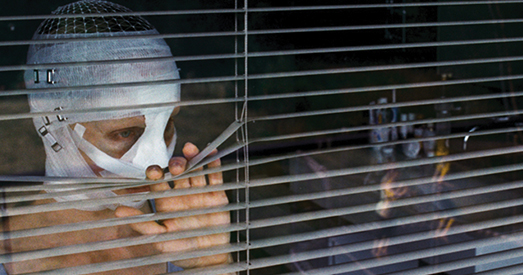 |
Los Angeles’ AFI Fest – I’m sorry, AFI Fest 2014 Presented by Audi, as they generally ask us to say at least once per article, is like Comic-Con for movie bloggers, in ways that are good and bad. It delivers the first looks of the season at many high-profile awards contenders, at screenings that are nigh-impossible to get a ticket to; and makes even the press have to wait in long lines to try and see anything else.
Fortunately for this site’s purposes, I’m less interested in covering the new Martin Luther King biopic than I am midnight movies about monsters, Paul Thomas Anderson’s attempt at a stoner comedy, and tense tales of criminals killing each other all over the world. Here are my full reviews of seven films (in no particular order) coming to, if not theaters, then at least an on-demand service near you soon.
(This took me all week to finish. Buckle up, and please note that not all embedded trailers are SFW.)
1. Inherent Vice.
The first thing you need to know about Paul Thomas Anderson’s Inherent Vice is that the plot is not important.
That’s not just my subjective opinion. After the show, we were actually handed programs prominently displaying a quote from the New York Times review of the Thomas Pynchon novel, explicitly saying the plot is not important. Though the truth is that the plot is rarely all that important in PTA pictures, which is why they usually require two viewings – one to figure out what will happen next, and another to figure out that the individual character moments, rather than what happened storywise, are the whole point. Now, as I’ve only seen it once, I feel at a disadvantage – for the moment I’ll say it feels overlong.
Not that he’s been without a sense of humor in the past, but this is Anderson’s most all-out comedy to date, as the director cites Cheech and Chong as inspiration, as well as Zucker-Abrams-Zucker. Ironically, though, those would be terribly superficial descriptions of the final product, which owes more to the Coen brothers, specifically The Big Lebowski (character and tone), and his most obvious all-time muse Robert Altman (length, vignette style, scenes unto themselves linked more thematically than narratively).
Joaquin Phoenix, in a role that almost went (and should have gone) to Robert Downey Jr., plays a 1970-era doctor named Doc, who’s also a major pothead and dabbler in the illegal. His story is narrated by a female voice, and I’m still not quite sure which one it is – there’s an ex-girlfriend and a daughter of an associate and they’re both played by unfamiliar actresses. Again, it doesn’t really matter. Doc’s ex wants him to look into a possible plot between her current boyfriend’s wife and her lover, and this basically serves as a springboard for Doc to travel across the city and run into all sorts of eccentric types, most notably a square-jawed cop named Christian “Bigfoot” Bjornsen (Josh Brolin, in the closest thing this movie has to an Oscar nomination lock).
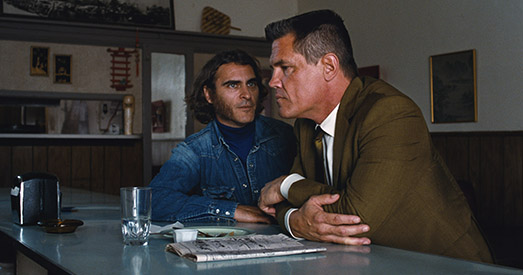 |
The interplay between Phoenix and Brolin is a thing of beauty; you could call it a hate-bromance (though maybe any relationship with a Brolin is a Bro-mance?). Christian has a penchant for eating frozen bananas very suggestively, and Doc likes to annoy him by bringing in his lawyer (Benicio Del Toro) to run interference, despite the fact that he’s only a maritime lawyer. Presumably lifted form the Pynchon novel, Anderson loads the story with fake place names and companies like “Gummo Marx Way” and the law offices of “Voorhees-Krueger”; Los Angeles’ hybrid cuisine is also a source of much mirth, as when Doc orders jellyfish teriyaki croquettes, or Christian insists on ordering his all-American breakfast at a Japanese place and keeps yelling “Moto Panicako!” at the chef every few minutes.
Other scenes vary in their quality. Owen Wilson’s moments as a missing musician-turned-informant are mostly dull and feel like they’re in the wrong movie, though Jena Malone’s main moment as his wife is excellent; meanwhile Martin Short is as good as I’ve ever seen him playing the drug-addled head of a secret dentist conspiracy group. The sheer amount of drugs and drug humor guarantee the film cult status, at minimum; I expect fan videos pitting Walter and The Dude against Doc and Christian as soon as the movie opens nationwide…or as soon as the people who feel like making them get around to it, maaaaaan.
Picture a Las Vegas buffet – there’s too much stuff on your plate, and a lot of it is stale chunks of melon. But then you come to the counter where they’re serving the crab legs, and for a moment, it is the best thing ever. Maybe next time, when you know where the good stuff is, your trip will be smarter and more strategic.
Will I watch it again to reassess? Maybe…at home…with some state-legal “medication.” And a fast-forward button.
2. It Follows.
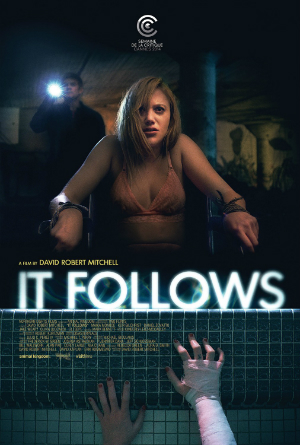 |
In a cinematic era of zombies, masked killers and invisible spirits, it’s quite a thing to come up with an original villain/creature. Yet director David Robert Mitchell has done it, and done so in an allegorical way you won’t soon forget.
If you’ve made it this far and you’re already sold on seeing the film, congratulations…and I suggest you not read further. The uniqueness of the threat is best left to unfold before your eyes. If, however, you are not yet persuaded, read on, and learn what might be feared most by a teenage girl jogging slowly away from her house as friends and family ask what’s wrong, only to find her the next day on a beach with all her limbs snapped backwards.
The thing that pursues victims in It Follows is a shape-shifter, which looks like a different person each time it is seen. It walks slowly, inexorably toward you, and can be outrun, but it will not be stopped or thrown off the scent, and if it catches you, you die (that it is only visible to the intended victim makes things extra-hard). The loophole that might permit survival is that you can transfer it to somebody else via sexual intercourse – it is the ultimate psychic STD. But if it then kills them, it’ll be back for you like a bad chain letter.
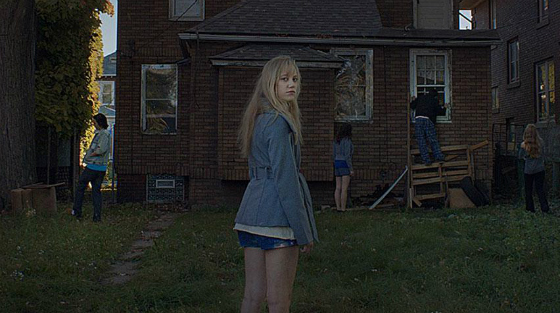 |
Given that it only walks, and can’t swim or fly, you’d think taking an international jet overseas would be a sufficient survival tactic, but of course it mostly latches on to teens, who don’t have that level of freedom. It can be read as a metaphor for many things – the slut-shame stigma of losing one’s virginity, vindicated by developing a healthy sex life; an STD and the metaphorical scarlet letter associated with it; or perhaps the trauma associated with rape, since this creature is generally transmitted under false pretenses. When you’re a teen, these are all things that feel like they may stalk you forever. Where this “It” differs from the likes of Jason Voorhees is in its more complicated relationship to sex: yes, it can mean death, but it can also be the key to survival.
Director Mitchell previously made The Myth of the American Sleepover, another movie involving young teens and desire, but in pursuit of a totally different end. He even uses similar key locales like the public swimming pool, but where that film was tender and real, this one is terrifying. The strength of both is in their realistic characters – here, unusually, attractive actresses fart and grossly trim their toenails like actual humans. Both movies are also unabashed throwbacks, as It Follows uses a John Carpenter-like synth score, but in earnest, never once rubbing your face in the notion that, “Hey, y’all this, is fuckin’ retro!”
I’ve heard naysayers spitball that the movie doesn’t go far enough, but when you have a totally new creature, I think you can’t get excessively complicated. There’s a primal fear at work here – everyone gets nervous about being followed – and even though the monster is fiction, I suspect the anxiety may pursue the viewer home.
3. The Tribe.
Is a movie made entirely in Ukrainian sign language nerdy? I’m going to go ahead and say yes.
It’s not a movie ABOUT being deaf, either – it’s a crime drama/thriller that just happens to be set in a Ukrainian boarding school for the deaf, where there are those in the administration who run mini criminal empires, and recruit the boys to do likewise. One thing you learn straight away is that if you’re ever on a train in Ukraine, keep your eye on the deaf kids selling small plush toys – they might just use it as a an excuse to enter every cabin and rifle through your things, taking what they wish.
Though there are no subtitles, nor any narration, the gist of the story is abundantly clear after a while. Yes, some “dialogue” scenes might have extra shades of meaning if you knew precisely what the hands were saying, but rarely is the main story in any way incomprehensible – this is a movie that will and should be used in cinema schools as a master class in how film is a visual medium.
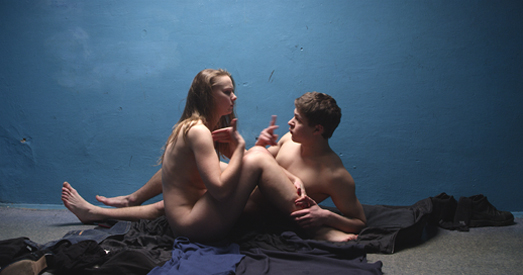 |
At first, there are echoes of Harry Potter – new kid comes to school, and is bullied and threatened by a blond, Draco Malfoy type – but once the kid proves himself by fending off a multi-faceted physical attack that he concludes by biting the Draco kid’s neck, he’s quickly brought into the fold, which includes not just robbery, but truck-stop prostitution, pimping out the only two girls we see at the school on a regular basis.
The plot thickens when the new kid falls for one of the girls he’s supposed to be pimping, as he finally pays for sex with her himself, and it’s the greatest thing ever (in this world, even those who would defend the girls still treat them as objects to be protected rather than people to be cared for). The Tribe is a movie that never cuts away or fades out when American movies would, so if you see a sex scene, you see the whole thing from beginning to end. If you see a murder or torture scene, you get that whole thing from beginning to end. And if there’s an illegal abortion scene…
An advantage The Tribe has over many other films is that with nobody talking, there’s no compelling need to record sync-sound, which frees up the camera to keep following the characters in long takes through different environments. Many of these shots make you aware that in a world of deaf people, a sleeping person will not hear a killer entering their bedroom…or even murdering the person in the next bunk.
The only part of the movie I felt needed more explaining was an extended bit about Italian passports. I assume Italy is considered a prime destination in Ukraine, and that obtaining transport there is difficult. I suppose I don’t need to know much more, but it seems that some cultural context there might have helped. Nonetheless…
Compelling, upsetting, brutal and brilliant, The Tribe is one of the best works of cinema of the year – a familiar template recreated in what, for most, will be an entirely new world.
4. Leviathan.
While The Tribe takes the modern gangster template and gives it a deaf Ukrainian spin, Leviathan offers the Russian take, which may offer a glimpse into why the two countries are so at odds today. In The Tribe, people fight to win; in Leviathan, everything just gets more and more depressing, as the film ultimately reminds us that in the end, nature does not give two shits about any of it and all will one day die. The director even introduced the film by telling us he wasn’t going to say “Enjoy it,” but rather, “Enjoy the first hour and 20 minutes.”
Also, Russians really give Americans a run for our money in being drunk assholes with guns. There’s a moment about halfway through the movie – right around that 1.20 mark – when most of the main characters go for a picnic, split an entire bottle of vodka four ways in four glasses, and use rifles and machine guns for a target practice game involving framed portraits of former Soviet leaders, from Lenin to Gorbachev (Yeltsin is too recent, they say). It’s no wonder they’re competitive with us.
The current leader’s portrait – a younger, idealized version of it – hangs conspicuously above the desk of the film’s main villain, a corrupt mayor named Vadim, who’s looking to grab a piece of prime shoreside real estate for himself using eminent domain. The current resident, Kolya, is none too happy about it, especially when he gets ridiculously lowballed in compensation, and Vadim shows up drunk just to yell at him one night, but his old army buddy is a successful Moscow lawyer with all the criminal dirt on Vadim that anybody would need to put him away. In theory.
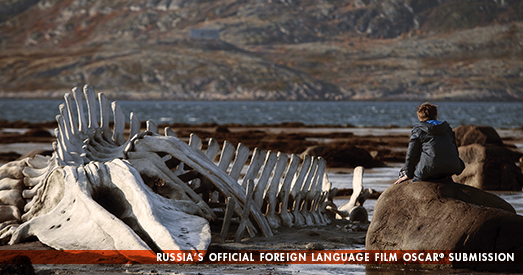 |
Sex again complicates things. Kolya is a widower who has married one of his late wife’s good friends, an arrangement his son is unhappy with, but his lawyer is not, as he happens to be banging her on the side. This naturally becomes an easy loophole for Vadim to exploit, particularly when he starts feeling cornered by the blackmail attempts.
The title can mean any number of things – it’s brought up literally quite late in the movie, as a local priest quotes from the book of Job in reference to Kolya’s suffering (a notable contrast to the Orthodox Bishop, who’s as in bed with government corruption as Vladimir Putin is with the current church). It could also refer to Vadim himself, a loathsome, corpulent monster of a man…or the oligarchy he’s part of. And it also applies to the large whale skeleton seen at the beginning and end of the movie, to show that even the largest things die, nature moves on, and like Matt Damon fighting Matthew McConaughey on a space iceberg, our petty struggles are insignificant next to all that.
Like so many Russian works of art, this is bleak, bleak stuff. You might want that four-way vodka by the end.
5. A Hard Day.
This Korean action movie is so propulsive and tight that I expect the American remake rights will be snapped up by the time you read this. Director Kim Seong-hoon has a way with suspense that would please Hitchcock, particularly since the guy you’re on pins-and-needles rooting for doesn’t necessarily deserve your sympathy at all.
Ko gun-su is driving home late at night, and swerves to avoid a cute dog in the road. With that mission accomplished, he lets up his guard for a moment, and hits a man running across the street instead.. Panicked, he puts the dead body in his trunk and continues…only to run smack dab into a DUI checkpoint. And he has been drinking. Still, he has a trump card, or so he thinks – tell the cops on duty that he’s a detective. But how to prove it?
Obviously the movie doesn’t end there, but there’s no need to spoil every excruciating, flop-sweating moment of Ko figuring out what to do. The meat of the story comes later, when he starts getting phone calls from someone who says he saw what happened. It’s creepy enough when the calls are anonymous, but before too long the identity of the blackmailer becomes clear, and it’s someone in a real position to hurt him. Meanwhile, it turns out that the dead man is one of the most wanted criminals in the city, so people are looking for the body.
 |
Each sequence expertly escalates the jeopardy, briefly resolves it to let you breathe, and then ups the ante some more, culminating in an amazing knock-down, drag out fight through Ko’s apartment. At one point, Ko decides to hide the body in the coffin of his recently deceased mother, and with an elaborate plan and a lot of luck, manages to get it inside without being caught – only to have the dead man’s cell phone ring from inside the newly re-sealed casket!
As I mentioned above, Ko isn’t necessarily a saint – I mean, he’s drunk driving when we first meet him. But Kim knows we can all relate to having the screws put to us, and as things go from bad to worse, we don’t care if Ko was the worst guy ever at his job, because it doesn’t matter. The story keeps us very much in the present, worrying about the next immediate threat even as a more long-term problem is evident. And when it finally comes down to fists and guns, the ensuing battle does not disappoint.
See this one immediately the first time you have a chance.
6. Goodnight Mommy.
A secret screening at Fantastic Fest, with some extremely creepy publicity stills released in advance, Goodnight Mommy looked like it had a lot of promise to be nightmare fuel. In its own way, it delivers on some of that – just not quite like you’d expect.
Honestly, without the festival hype, this would probably be a quickly forgotten number, a low-key bit of horror with a gimmick, that just happens to be from Germany Austria (its title in their vernacular is I See, I See. And I might have appreciated it more – going in thinking, “Holy shit, Tim League himself picked this to be Fantastic Fest’s big surprise,” I was ready for a film to BRING IT.
Should I be mad that I just got a decent hot dog instead of a gourmet, spicy Bratwurst? Nahh. That’s my fault, not the movie’s.
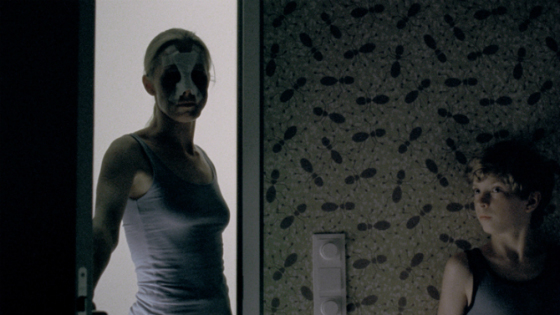 |
Brothers Lukas and Elias have a mommy who was in an accident and comes home a little…different. With bandages all over her face, she’s a mommy mummy, unrecognizable to the boys, and her behavior seems particularly strange to Elias. Is it possible she’s not who she says she is? And if she’s somebody new, what does this stranger have to gain by impersonating a mother?
It’s best not to give away too much – even from that premise, you should know enough to tell that some amount of mystery is part of the lure. Suffice it to say that there is a point where the bandages do come off, gross-outs involving pet cockroaches ensue, and there are some heinous acts committed, all for reasons that won’t be made fully clear until the end of the movie.
Not that anything’s convoluted – this is a simple story with few characters that relies on a mystery. I’m not sure it’ll bear a second viewing particularly well once you know what’s coming, but its suspense level is mildly above average. Like Stephen King, when it fails to scare , the movie goes for the gross-out, with torture moments that verge on pornographic in implication (though not exactly what you might think of as “torture porn”) and dream scenes that deliver extra gore (because with a cast this small, you can only get your kills in if some of them are imaginary).
Still, Mommy is never as scary in the film as she looked in that first image I saw from it in Fantastic Fest write-ups. I guess what I’m saying is that cinematographer Martin Gschlacht (Luna Papa, I write here as if I know what that is, kinda thinking I half-remember it) is the real star here.
7. Alleluia.
Gloria (Lola Duenas, Talk to Her) is a lonely morgue worker looking for a man via online dating. Michel (Laurent Lucas), the man she is to meet tonight from online dating, prepares to meet her by conducting some sort of dark ritual, and practicing exactly what lines he’ll use on her. But it goes well – he’s a shoe salesman and a success, and they hop into bed pretty swiftly, with Gloria so confident in this new man that she even lets him watch her kid the next day. Meanwhile, he notices that old family photos around the house have her husband’s face brutally, frantically scratched out.
He asks her for money. She gives it, saying, “If you don’t help the people you love, you don’t really love them.” It’s love for her at first sight, or at least first fuck, and she calls him immediately. He’s less interested, as he is in fact a con man who seduces women to get their money. But she’s the truly crazy one, and she stalks him, telling him she doesn’t care about what he does as long as she can have him. He’s messed up in other ways, prone to constant migraines and talking of times during his childhood when his mother would take him into her bed and show him how to give pleasure.
So they start working together. He seduces and even marries other women, and she pretends to be his sister. There’s just one small problem – every time he has sex with the mark to seal the deal, Gloria has a tendency to go berserk and beat the other woman to death.
Yeah. It’s that kind of relationship.
 |
Based on American serial killers Martha Beck and Raymond Fernandez, Fabrice Du Welz’ film resets the action in contemporary Belgium, where victims would seem to be a lot more plentiful give the online dating scene versus the personal ads of yesteryear. Although in the modern world, you’d also think there might be more inquiries about the bodies. Gloria’s morgue experience makes her expert at dismemberment – there’s even a musical number that takes place while she saws off a foot – but her evident lack of sanity ought to be a massive red flag for any detective who might come looking. Fortunately for her, none does.
This isn’t a movie about killers hiding from the law, as a true Beck/Fernandez biopic would be, but a tense relationship drama with the heightened jeopardy of a man who insists on doing things that he knows will drive his lover homicidal, even as she assures him she’s fine with it. It’s the ultimate example of male-female communication issues, as who among us has not had the “You said it was okay!” versus “You should have known what I meant!” argument in a relationship? This could have been played for satire, but instead each eruption of anger is like a brain spasm, with cameras going frenetic in a way that makes the audience member feel like he or she is having an anger blackout. I’ve spoken to people who’ve had PTSD rages, and they say they see red and can’t remember what they did – until a movie can actually erase your memory, this kind of disorientation simulation comes close.
What’s difficult is finding a way to relate to the story. I suspect audience sympathies may break down along gender lines at first, but after a while, you see the lead couple voluntarily bringing danger upon themselves, and just feel bad for those caught in between, who don’t really stand a chance. Perhaps there’s a misbegotten idea to make this a franchise, as it leaves you feeling as a typical horror movie does that aspires to sequels – they could have resolved the story, and didn’t.

